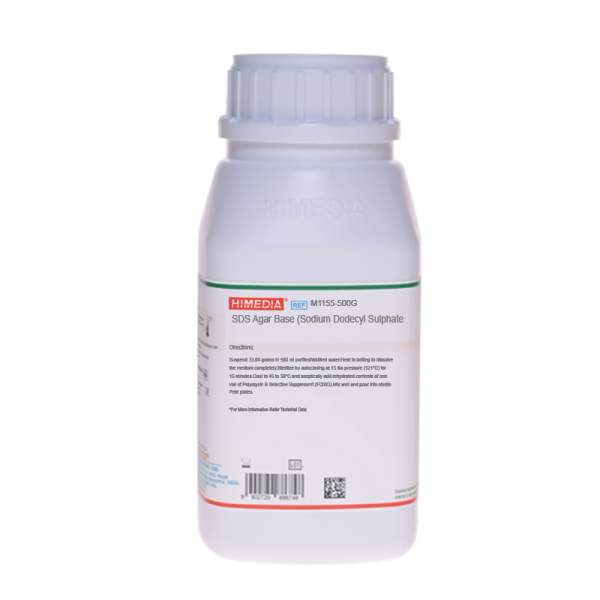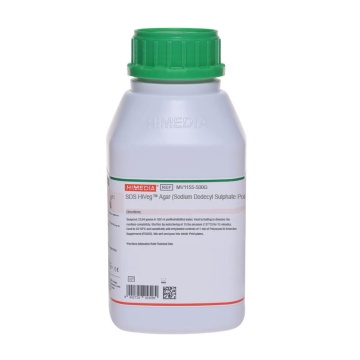 Your enquiry has been submitted
Your enquiry has been submitted
SDS Agar Base (Sodium Dodecyl Sulphate Polymyxin Sucrose Agar Base)
Intended Use
Recommended for enrichment, isolation and enumeration of Vibrio vulnificus from seafood samples in accordance with APHA, ISO/TS 21872-2 and ISO 11133 :2014 (E) : Amd. 2020.
Composition
| Ingredients | g/L |
|---|---|
| Proteose peptone | 10.000 |
| HM peptone B # | 5.000 |
| Sucrose | 15.000 |
| Sodium chloride | 20.000 |
| Sodium dodecyl sulphate | 1.000 |
| Bromothymol blue | 0.040 |
| Cresol red | 0.040 |
| Agar | 15.000 |
Final pH (at 25°C): 7.6±0.2
Formula adjusted, standardized to suit performance parameters
# - Equivalent to Beef extract
Directions
Suspend 33.04 gram in 500 ml purified / distilled water. Heat to boiling to dissolve the medium completely. Sterilize by autoclaving at 15 lbs pressure (121°C) for 15 minutes. Cool to 45-50°C and aseptically add rehydrated contents of 1 vial of PolyB Selective Supplement (FD003). Mix well and pour into sterile Petri plates.
Principle And Interpretation
Vibrio vulnificus is a gram-negative, motile, curved, rod-shaped bacterium. Present in marine environments such as estuaries, brackish ponds, or coastal areas, V.vulnificus is closely related to V.cholerae, the causative agent of cholera (1,2). V.vulnificus causes an infection often incurred after eating seafood, especially oysters. The bacteria can also enter the body through open wounds when swimming or wading in infected waters (2). SDS Agar is formulated as described by Bryant et al (3) for differentiation of V.vulnificus from other Vibrio. SDS Agar is recommended by APHA (4) and ISO / TS 21872-2 (5) and ISO 11133-2014 (6) for isolation and enumeration of V.vulnificus from foods. V.vulnificus is a causative agent of septicemic shock associated with consumption of raw oysters. V.vulnificus forms distinctive colonies which are round, purple/green colonies with an opaque halo about 2 to 3 mm in diameter.
The medium contains proteose peptone and HM peptone B which provide nitrogen and carbon source, long chain amino acids, vitamins and necessary growth nutrients. Sucrose is a fermentable sugar. Addition of 2% sodium chloride to the medium provides necessary salinity for the growth of Vibrio. Bromothymol blue and cresol red act as pH indicators. Sodium dodecyl sulphate and polymyxin B sulphate are the selective agents.
Type of specimen
Food samples
Specimen Collection and Handling
For food samples, follow appropriate techniques for sample collection and processing as per guidelines (4-6).
After use, contaminated materials must be sterilized by autoclaving before discarding.
Warning and Precautions
Read the label before opening the container. Wear protective gloves/protective clothing/eye protection/ face protection. Follow good microbiological lab practices while handling specimens and culture. Standard precautions as per established guidelines should be followed while handling specimens. Safety guidelines may be referred in individual safety data sheets.
Limitation
- Individual organisms differ in their growth requirement and may show variable growth patterns on the medium.
- Each lot of the medium has been tested for the organisms specified on the COA. It is recommended to users to validate the medium for any specific microorganism other than mentioned in the COA based on the user's unique requirement.
Performance and Evaluation
Performance of the medium is expected when used as per the direction on the label within the expiry period when stored at recommended temperature.
Quality Control
Appearance: Cream to yellow homogeneous free flowing powder
Gelling: Firm, comparable with 1.5% Agar gel
Colour and Clarity of Prepared Medium: Reddish purple coloured clear to slightly opalescent gel forms in Petri plates
Reaction: Reaction of 6.6% w/v aqueous solution at 25°C. pH: 7.6±0.2
pH: 7.40-7.80
Cultural Response
Productivity: Cultural characteristics observed after an incubation at 37±1°C for 24±3 hours with added PolyB Selective Supplement (FD003).
Selectivity: Cultural characteristics observed after an incubation at 37°1°C for 24±3 hours with added PolyB Selective Supplement (FD003).
| Organism | Inoculum (CFU) | Growth | Characteristic reaction |
|---|---|---|---|
| Productivity | |||
| Vibrio cholerae non-01 / non-0139 ATCC 14733 (00203) | 103-104 | good | yellow colonies with an opaque halo |
| Vibrio vulnificus ATCC 29307 (00187*) | 103-104 | good | purple/green colonies with an opaque halo |
| Selectivity | |||
| Escherichia coli ATCC 25922 (00013*) | >=104 | inhibited | |
| Escherichia coli ATCC 8739 (00012*) | >=104 | inhibited | |
| Escherichia coli ATCC 11775 (00090*) | >=104 | inhibited | |
Key: (*) Corresponding WDCM numbers.
Storage and Shelf Life
Store between 10-30°C in a tightly closed container and the prepared medium at 2-8°C. Use before expiry date on the label. On opening, product should be properly stored dry, after tightly capping the bottle in order to prevent lump formation due to the hygroscopic nature of the product. Improper storage of the product may lead to lump formation. Store in dry ventilated area protected from extremes of temperature and sources of ignition. Seal the container tightly after use. Product performance is best if used within stated expiry period.
Disposal
User must ensure safe disposal by autoclaving and/or incineration of used or unusable preparations of this product. Follow established laboratory procedures in disposing of infectious materials and material that comes into contact with sample must be decontaminated and disposed of in accordance with current laboratory techniques (7,8).
References
- Oliver J. D., Kaper J., 2001, Vibrio species. pp. 263-300 In: Food Microbiology: Fundamentals and Frontiers, (Doyle M.P. et al, Editors), 2nd Ed., ASM Press. 1555811175.
- Oliver J. D., 2005, "Wound infections caused by Vibrio vulnificus and other marine bacteria", Epidemiol. Infect. 133 (3):383-91.
- Bryant R. G., Jarvis J. and Janda J. M., 1987, Appl. Environ. Microbiol. 53:1556.
- Salfinger Y., and Tortorello M.L., 2015, Compendium of Methods for the Microbiological Examination of Foods, 5th Ed., American Public Health Association, Washington, D.C.
- Microbiology of the food chain Horizontal method for the determination of Vibrio spp. Part 2: Enumeration of total and potentially enteropathogenic Vibrio parahaemolyticus in seafood using nucleic acid hybridization. ISO/TS 21872-2:2020
- Microbiology of food, animal feed and water- Preparation, production, storage and perfoemance testing of culture media, ISO 11133:2014 (E) Amd. :2020.
- Isenberg, H.D. Clinical Microbiology Procedures Handbook 2nd Edition
- Jorgensen, J.H., Pfaller, M.A., Carroll, K.C., Funke, G., Landry, M.L., Richter, S.S and Warnock., D.W. (2015) Manual of Clinical Microbiology, 11th Edition. Vol. 1.
| Product Name | SDS Agar Base (Sodium Dodecyl Sulphate Polymyxin Sucrose Agar Base) |
|---|---|
| SKU | M1155 |
| Product Type | Regular |
| Physical Form | Powder |
| Origin | Animal |
| Packaging type | HDPE |
| References | 1. Oliver J. D., Kaper J., 2001, Vibrio species. pp. 263-300 In: Food Microbiology: Fundamentals and Frontiers, (Doyle M.P. et al, Editors), 2nd Ed., ASM Press. 1555811175. |
| Customized Product Available | No |







